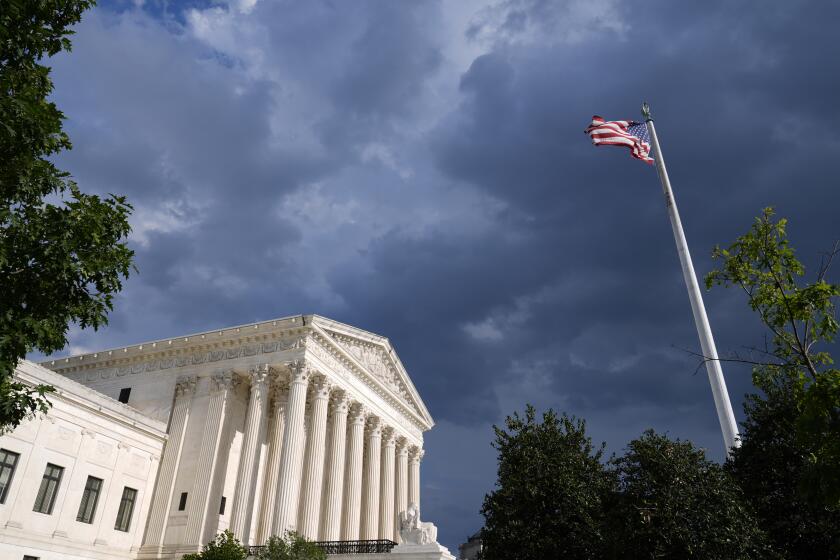Closely divided Senate is rare; how will the chamber function?

- Share via
Reporting from Washington — In 1953, with Republicans holding a one-seat majority as the new Senate convened, independent Oregon Sen. Wayne Morse saw himself in a unique position of power.
To reinforce the point, he made a conspicuous entrance to the chamber on the session’s first day, carrying with him a metal folding chair to place in the center aisle that divided the two parties.
A former Republican who had just left the party to protest what he thought was its lurch to the right, Morse eventually took what had been his regular seat on the Republican side of the aisle. But rather than turning him into a kingmaker, Morse’s independent status eventually led him to be stripped of his cherished committee assignments. He cursed his former party’s leader over “terroristic” tactics.
“I represent the people of Oregon … and I also am spokesman of hundreds of thousands of independents who refuse to accept kinship with the donkey and who cannot and will not follow the lumbering meanderings of the elephant,” he said after losing a vote that would have given him back key committee seats. “These hundreds of thousands of American citizens cannot be ignored merely because they have not yet learned the ways of the local political clubhouse.”
Three generations later, the Senate could soon find itself in a similar position: narrowly divided and potentially at the whim of a handful of mercurial, independent-minded senators. But Morse’s case shows how unpredictable such a situation could be.
Democrats hold a 10-seat majority in the Senate, benefiting for the moment from two independents who vote with them. That majority is very much in doubt in Tuesday’s midterm elections, with Republicans seemingly in position to pick up the six seats they’d need to win back control.
If it’s just six, or if Democrats manage to retain a narrow advantage, the Senate would be in a rare situation. For most of recent history, one party or the other has enjoyed a workable Senate majority. After the decade when Morse’s folding chair came into play it would be 40 years before the Senate would see such a close divide.
After the 2000 elections, Democrats and Republicans each held 50 seats, requiring a unique power-sharing arrangement that accounted for the fact that Republicans had only nominal control thanks to a tie-breaking vote by then-Vice President Dick Cheney. But within months, a Republican senator, Vermont’s Jim Jeffords, switched to become an independent and put Democrats in the majority.
Since then, neither party has had only a single-seat majority, and only twice since has a majority party’s advantage been as slim as two seats – for Republicans after the 2002 election, and for Democrats after 2006.
Aides to leaders in both parties acknowledge the challenges that would come with such a narrow majority and the unpredictability that would follow.
The biggest potential wild card would be the election of Greg Orman, an independent from Kansas challenging incumbent Republican Pat Roberts. Orman has steadfastly refused to say which party he’d caucus with, and indicated that if he is asked to be a majority-maker, he’d use the leverage to advance a “problem-solving agenda.”
In one debate, Orman said he would not vote for either Harry Reid or Mitch McConnell as majority leader, which prompted Roberts to point out that Orman might find himself with no committees to serve on and little influence, just as Morse had.
If the GOP doesn’t win a clear majority, there could be a push to persuade certain members to switch parties, as Jeffords did in 2001. Maine independent Sen. Angus King is the most-often mentioned candidate for such a move, and he has not completely ruled out the possibility of shifting his loyalties to the GOP. But the second-year lawmaker has said the most likely price for a caucus change – a committee chairmanship – is unlikely to be offered to the second-year lawmaker, particularly with established Republicans eager to reclaim the gavels.
West Virginia Sen. Joe Manchin, a centrist Democrat, is another oft-mentioned potential party switcher, but aides insist he’s not considering it.
Though party leaders might continue to seek out possibilities to lure senators from one side of the aisle to the other, aides say most of the efforts in a divided Senate would have to focus on how to use the body’s vexing rules and the growing frustration of some members to draw others out of their partisan corners and find consensus. For more than a year, current Senate Majority Leader Reid has regularly used his power to prevent amendments from being offered to legislation that might put vulnerable Democratic members – or the White House – in a difficult political position. Reid has maintained he’s been forced to do so because Republicans won’t negotiate in good faith on which and how many amendments the party would offer.
Close allies of McConnell and Reid – New York Democrat Charles Schumer and Tennessee Republican Lamar Alexander – had sought to break the gridlock by seeking bipartisan agreements to advance some low-wattage legislation in the hope it would spur momentum toward getting the Senate back into a more collaborative spirit. It worked on one bill to authorize block grants to states for child care. But the next effort to advance an energy conservation measure was derailed by election-year politics because one of its chief sponsors, New Hampshire Democrat Jeanne Shaheen, was a top GOP target.
Alexander and Schumer might seek to resume their efforts in a new Senate, aides say, hoping the outcome of this year’s election will spur lawmakers to reconsider the approach. Various groups of mostly junior lawmakers have also been discussing ways to force leaders to open up the legislative process.
Reid has not signaled how he might change his approach if Democrats retain control, but McConnell has made such procedural issues a key part of his election bid, promising to restore an unlimited amendment process on legislation and extend the chamber’s workweek to increase the opportunity for consensus.
“We won’t all agree, of course, on the particulars of every single proposal,” he said in a major speech this year outlining the approach he would take as majority leader. “But that’s OK. The idea isn’t to agree on everything. It’s to have a serious debate that leads to good, durable results.”
Democrats who are skeptical that McConnell would follow through point to the divide among Republicans that McConnell would need to navigate, particularly between blue-state Republicans who will be seeking reelection in 2016 and potential GOP presidential hopefuls like Sen. Ted Cruz (R-Texas) who will probably want to burnish their conservative credentials. In a recent interview with the Washington Post, Cruz signaled his preference that the GOP take a combative approach rather than seek consensus.
But another potential White House aspirant has endorsed McConnell’s approach.
“Even if we get a majority, we still will need some Democrats to vote with us,” Sen. Rand Paul (R-Ky.) told reporters Monday. “We’ll talk to them, work with them and we’re going to get things passed.”
Follow @mikememoli for more news out of Washington.
More to Read
Get the L.A. Times Politics newsletter
Deeply reported insights into legislation, politics and policy from Sacramento, Washington and beyond. In your inbox twice per week.
You may occasionally receive promotional content from the Los Angeles Times.











